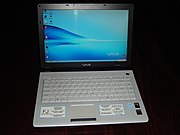
VAIO
From Wikipedia, the free encyclopedia
| This article needs additional citations for verification. Please help improve this article by adding reliable references. Unsourced material may be challenged and removed. (July 2008) |
| This article may require cleanup to meet Wikipedia's quality standards. Please improve this article if you can. (August 2007) |
VAIO (pronounced /vi/ /oʊ/) is a sub-brand for many of Sony's computer products. It was originally an acronym for Video Audio Integrated Operation, but since 2008 amended to Visual Audio Intelligence Organizer to celebrate the brand's 10th year anniversary. The branding was created by Timothy Hanley to distinguish items that encompassed the use of consumer audio and video, as well as being conventional computing products. One example of this was the Sony VAIO W Series personal computer, which functioned as a regular computer and a miniature entertainment center. Although Sony made computers in the 1980s for the Japanese market only, Sony withdrew from the computer business around the turn of the decade. Sony's re-entry to the computer market, this time globally, under the new VAIO brand, started in 1996 with the PCV series of desktops. The VAIO logo also represents the integration of analog and digital technology. The 'VA' represents an analog wave and the 'IO' represents digital binary code.
Contents[hide] |
[edit] Products
Sony is expanding the use of the VAIO label. It can now be found on notebooks, subnotebooks, desktop, media centres, and a hard-disk-based audio player that comes in both 20GB and 40GB variations (called VAIO POCKET player). Network media solutions by Sony will also carry the VAIO brand.
VAIO notebooks are usually shipped with Microsoft Windows Vista Business (Business line) or Windows Vista Home Premium, with the highest end of the AR series spec being the exception, coming with Windows Vista Ultimate.
In mid-2005, all models stopped shipping with a Recovery CD, which was replaced by a hidden partition on the hard drive, accessible at boot via the BIOS or also within Windows via a utility. The partition allows the user to either reimage his hard drive to factory state, or to create recovery media. VAIO users are prompted to create a set of recovery CDs or DVDs as part of the out-of-box experience, along with a prompt to register at My Club Vaio, an internet forum for VAIO users which also provides automatic driver updates and technical support via email, along with exclusive desktop wallpapers and promotional offers.
On recent models, you are also prompted to register your trial versions of Microsoft Office and the installed antivirus software (Norton Anti-Virus on older models, and McAfee Antivirus on newer ones) upon initial boot.
VAIO computers come with components from companies such as Intel processors, Seagate Technology, Hitachi, Fujitsu or Toshiba hard drives, Infineon RAM, Atheros and Intel wireless chipsets, Sony (usually made by Hitachi) or Matsushita optical drives, Intel, NVIDIA or ATI graphics processors and Sony speakers. Recent laptops are being shipped with Qimonda RAM, HP speakers with Realtek High Definition Audio Systems, optional Dolby Sound Room technology.
[edit] Technology
The VAIO brand holds many unique technologies to its name. Some of these are:
Some Sony VAIO models come with Sony's proprietary XBRITE (also named as ClearBright in Japan and Asia-Pacific region) displays. The first model that introduce this feature is the VAIO TR series. It is also the first consumer product to utilize such technology. It is a combination of smooth screen, anti-reflection (AR) coating and high-efficiency lens sheet. Sony claims that the smooth finish provides a sharper screen display, the AR coating prevents external light from scattering when it hits the screen, and the high-efficiency lens sheet provides 1.5 times the brightness improvement over traditional LCD designs, while also extending battery life due to less usage of the LCD backlight. The technology was pioneered by Sony engineer Masaaki Nakagawa, who is in charge of the VAIO TR development. More information can be found here: [3].
The TX series introduced in September 2005 was the first notebook to implement an LED back-lit screen, which provides lower power consumption and greater color reproduction. This technology has been widely adopted by many other notebook manufacturers now. It was also the first to use a 16:9 aspect ratio screen with 1366x768 resolution.
The SZ series was the first to use switchable graphics, integrated Intel and discrete Nvidia graphics. The former could be used for less power consumption and greater battery life whereas the latter would be used when greater graphics processing power was needed. A switch is used to toggle between the graphics but required a cold-boot. The Z series has recently replaced the SZ series but does not require a restart of the system to change graphic modes, it can be done on the fly. This feature has subsequently been used by other manufacturers, including Apple, Asus and Alienware.
The high-end AR Series VAIOs were the first to incorporate a Blu-ray Disc burner. This series was designed to be the epitome of high-definition products including a 1080p capable WUXGA (1920 × 1200 pixels) screen, HDMI output and the aforementioned Blu-ray burner. The AR series also includes an illuminated logo below the screen. Blu-Ray/HDMI capable models have been the subject of intense promotion since mid-2007, selling with a variety of bundled Blu-Ray discs.
Another recent addition to the VAIO series is the TZ model. This new design features a 64GB Solid State Drive (SSD) for rapid boot-ups, quicker application launches and greater durability. If selected, a 250GB Hard Drive may also be included in place of the built-in CD/DVD drive to provide room for additional storage. For security this model includes biometric fingerprint sensor and Trusted Platform Module. The TZ offers a Built-in highly miniaturized MOTION EYE camera built into the LCD panel for video conferencing. Additional features include the XBRITE LCD, integrated Wireless Wide Area Network (WWAN) technology and Bluetooth technology.
A selection of media centers were added to the VAIO range in 2006. These monitorless units (identified by a product code prefixed by VGX rather than VGN) are designed to be part of a home entertainment system, which typically take input from a TV tuner card, and output video via HDMI or composite video connection to an ideally high-definition television. This range so far includes the XL and TP lines. The VGX-TP line is rather visually unique, featuring a circular, 'biscuit-tin' style design with most features obscured behind panels, rather than the traditional set-top box design.
The VAIO line also features a series of desktop computers, which incorporate motherboard and widescreen LCD monitor into a single unit (in a manner similar to the more recent models of Apple's iMac series). These are identified by VGC in the product code.
[edit] Bundled software
Sony has been criticized for loading its VAIO laptops with bloatware, or software that supposedly allows the user to immediately use the laptop for multimedia purposes. Sony forces users to install software such as AOL, Norton, SonicStage, Napster and Roxio, among countless "free trials" and intrusive advertisements. Dell had been accused of the same practice, but after strong customer feedback agreed to offer "limited" pre-installed software on its machines.[1]. The default webcam software in VAIO notebooks is ArcSoft WebCam Companion. It offers a set of special effects called Magic-i visual effects, through which users can enhance the images and videos taken through the webcam. It also features the face detection feature. Certain other Sony proprietary software such as Click to Disc Editor, VAIO Music Box, VAIO Movie Story, VAIO Media Plus are also included in the recent models. Those shipped with ATI Radeon Video cards feature the Catalyst Control Center, which enables the user to adjust the various video features such as brightness, contrast, resolution etc, and also enables connecting with an external display.
[edit] Current models
[edit] Consumer laptops
- AW Series[2] - Sony's flagship model. 18.4" High-end multimedia machine, with 1080p resolution screen and SSD options. Replaces AR series.
- AR Series (discontinued) - Display of 17", with 1080p capable screen, HDMI output and the optional BD burner.
- FW Series[3] - The world's first 16.4" notebook, features Blu-ray Disc burner.
- FZ Series (discontinued) - A 15.4" notebook, features Blu-ray Disc burner in high end model. Marketed as the ultimate HD entertainment notebook with HD LCD screen in all the models.
- CR Series (discontinued)[4] - New 14" successor of the C series. Marketed as a 'lifestyle' laptop ("Whether you're studying at the coffee shop or out on the town with friends, the VAIO CR has the head-turning looks to get you noticed"), available in red, blue, pink or white. Sony were one of the first manufacturers to offer notebook computers in multiple colors - a feature later offered most notably by Dell, which produced a series of TV advertisements in mid-2008 stressing this feature[citation needed].
- CS Series - A 14.1" notebook marketed as a slightly higher end laptop compared to CR Series with multiple variant for users to choose from.
- NR Series (discontinued)[5] - 15.4" entry level Vista laptop for home users.
- NS Series[6] - 15.4" entry level Vista laptop for home users. Successor of the NR Series.
- P Series - 8" notebook that uses a 1.33 GHz Intel CPU, runs on Windows Vista, does not have an optical drive, but has a GPS.
[edit] Professional laptops
- TZ Series[7] - Ultra portable 11.1" professional notebook (1.2kg)
- TT Series[8] - Ultra portable 11.1" professional notebook. The smallest notebook computer to accommodate a Blu-ray Disc drive at 11 inches.
- Z Series[9] - 13.1" Ultra portable, featuring a WXGA++ display with a 1366 x 768 and an optional 1600 x 900 resolution and integrated WWAN. (Replaces the high-end models of the SZ Series.)
- SR Series[10] - 13.3" Ultra portable, aimed at young professionals for home and business use. (Replaces the low-end models of the SZ Series.)
- BZ Series[11] - Robust business notebooks with Trusted Platform Module and biometric fingerprint security technology. (Replaces the BX Series.)
From Q2 of 2008, all models (starting with the SR, FW, BZ, and Z-series) have incorporated a cylindrical spine, with no ports on the back of the computer. Generally, the AC adapter port is located on one end of the cylindrical spine, and the power button on the other.
[edit] Heat problems
- On September 4, 2008, Sony announced a worldwide voluntary product inspection and rework program for TZ-series notebook computers manufactured since June 2007. All model numbers beginning with VGN-TZ1 and VGN-TZ2 were eligible, along with some VGN-TZ3 notebooks. The issue involves "a limited number of units" which could potentially "generate heat around the DC jack inlet and frame of LCD screen, which creates the potential of deformation of the plastic casing"[12]. In the United States, the service offered is generally on-site, whilst in the rest of the world the service typically involves collection of the notebook by a courier, often DHL, for servicing in a Sony repair centre. ChannelWeb reports 100,000 have been recalled.
[edit] Desktops/Digital home
- L Series[13] - 24" (LV Series. Features Full HD 1080, hybrid TV Tuner and Blu-Ray reader/recorder. Able to record TV shows on Blu-Ray) 20" (LN Series. Slightly lower end than LV Series. Features Blu-ray reader rather than recorder) 19" (LM Series) and 22" (LT Series) All-in-one
- TP Series[14] - Mini PC
- RM Series[15] - HD Workstation
- HS Series - Home Server.
Nearly all Sony VAIO computers have hardware virtualization technology (VT) disabled,[16] the exception being the new BZ range, which uses an Aptio BIOS by American Megatrends, rather than the customized Phoenix BIOS common on older models. The feature can be re-enabled by booting from a DOS disk and manually modifying the BIOS, but it is a relatively advanced and technical task.
Released in late 2008, the HS series are a fully-featured DLNA Certified media server. It is similar to the TP series in looks, albeit slightly smaller. The main differences from the rest of the VAIO range are that, surprisingly, it runs a VAIO-specific version of Linux rather than the standard Microsoft Windows products, and that it has no video output of its own, so must be accessed via a client machine over a network.
[edit] See also







 Delicious
Delicious Digg
Digg StumbleUpon
StumbleUpon Reddit
Reddit Newsvine
Newsvine Facebook
Facebook Google
Google Yahoo
Yahoo




















Nice post
nice post...
try to give a two line describer about the post.